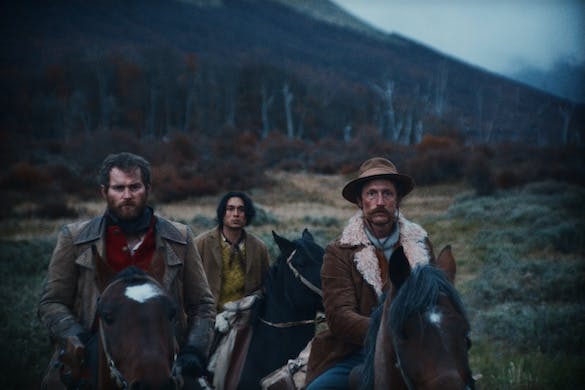‘The Settlers’ Settles for a History Lesson, With the Occasional Digression
Like its lead character, who is part Indian and part of European descent, ‘The Settlers’ is divided between impulses: whether to entertain or educate, to digress or hone in, to expose atrocities or tactfully address them.

The new Chilean film “The Settlers” opens on an image of a lone guanaco, a relative of the llama, in a landscape of pale green and brown brush and distant hills. It’s a lovely, painterly image soon replaced with thousands of sheep roaming similar land. Tierra del Fuego is the place, the year is 1901, and director Felipe Gálvez Haberle has just presented us with a mini-preview, reinforced by a Thomas More quote, of what we’re about to watch: a story of the erasure of an indigenous population by settlers and profiteers.
Mr. Gálvez bases his narrative around real events — the systematic murder of the Selk’nam, a people native to the southern regions of Chile and Argentina. It’s an ambitious project for a first feature film. Like Martin Scorcese’s “Killers of the Flower Moon,” the work explores a little-known, reprehensible episode in history, this time in Chile. In press notes, the director discusses the official inquiry made into the incidents more than a hundred years ago, stating, “Hundreds of testimonies recount the slaughter and persecution of the native populations, but no convictions were ever made.”
As a corrective history lesson, the movie occasionally enlightens with its mixture of real-life personages and situations with fictional characters, relaying a potent message on colonialism, genocide, and remembrance. Yet as a film, the picture works only fitfully, with a majority of its runtime devoted to Western-style tropes, and its second section more of a political snapshot. Like its lead character, Segundo, who is part Indian and part of European descent, “The Settlers” is divided between impulses–whether to entertain or educate, to digress or hone in, to expose atrocities or tactfully address them.
The plot of the film’s first storyline is introduced early on: José Menéndez, a landowner and sheep farmer, tasks MacLennan, a Scot and former lieutenant with the British army, with ridding the Indians from his land after accusing them of killing his sheep. For this mission, MacLennan takes Segundo with him, as well as an American named Bill, who, according to Menéndez, can sniff out Indians wherever they may be. Bill is a believer in the intellectual divide between whites and people of color, and immediately expresses a distrust in Segundo’s allegiances. MacLennan, in turn, vouches for Segundo, though the group dynamic between the three prickles with tension.
As they roam the devastatingly beautiful landscape looking for the Ona, another name for the Selk’nam people, they come upon Argentine military personnel and government surveyors. These men have traveled to this harsh area at the foot of the Andes mountains in order to map out the border between the two countries. This interlude, while mildly informative, goes on too long, especially when MacLennan and his cohorts partake in manly games with the soldiers. Accompanied by jaunty music, this segment feels clichéd and extraneous, particularly because we sense the monstrous bloodshed yet to come.
A slaughter does eventually happen, though we later learn that the one depicted isn’t among the biggest massacres enacted on the Selk’nam. With no provocation or questions asked about whether this tribe participated in the culling of Menéndez’s sheep, MacLennan and Bill start shooting at a small, defenseless clan.
It’s a harrowing scene, despite Mr. Galvez and cinematographer Simone D’Arcangelo enveloping the action within fog. The aftermath provides further shocks and anguish, reflected most of all in the placid outrage of Segundo’s face. Except for one distressing moment, actor Camilo Arancibia embodies the conflicted character as someone stunned by all that he sees and unable to react.
The rest of the cast play their parts according to what little traits they’re given, though Mark Stanley as MacLennan does complicate his almost sadistic character with some interiority. Soon, though, after another discursive interlude involving a British colonel, the movie jumps ahead several years and starts to focus on the Chilean government’s investigation into the mass murder.
During this section, the filmmakers explore the machinations of politics and revisionist spin, and the film becomes talky and static. Nevertheless, the final scene uses this fixity to great effect, and reminded me of the following John Adams quote, which he made, ironically, in defense of the British soldiers involved in the Boston Massacre: “Facts are stubborn things; and whatever may be our wishes, our inclinations, or the dictates of our passion, they cannot alter the state of facts and evidence.”

